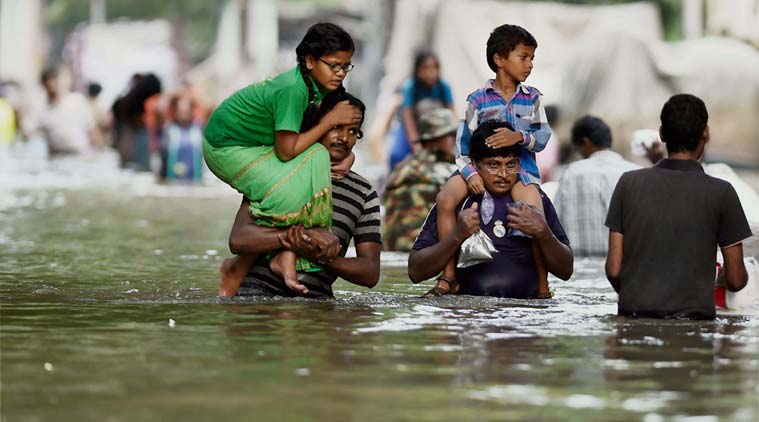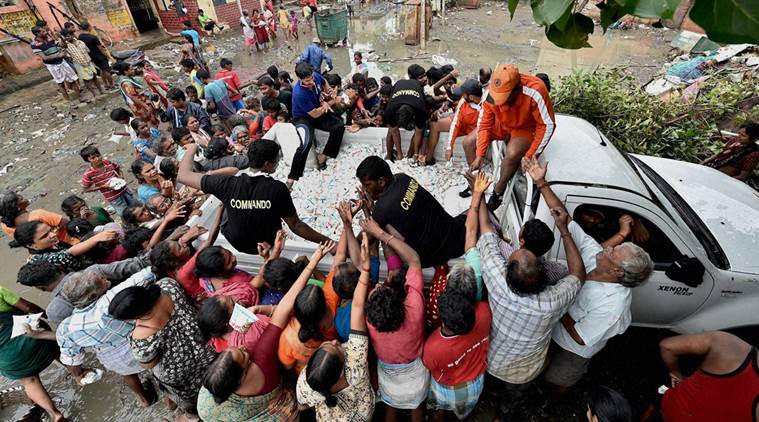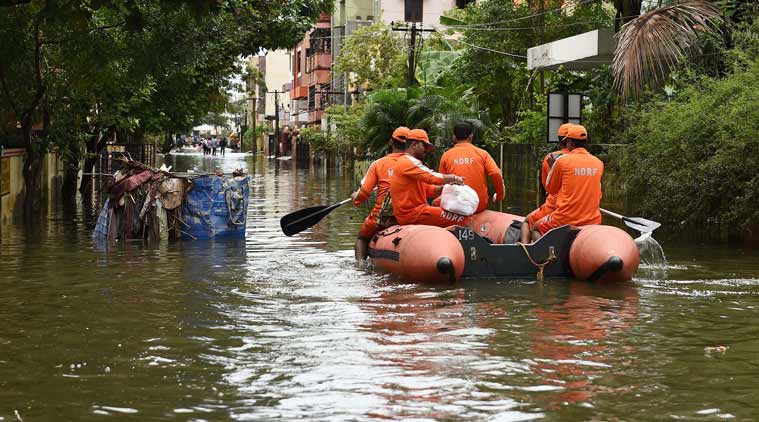 Children along with their family members wading through waist-deep water in Chennai after heavy downpour on Thursday. (PTI Photo)
Children along with their family members wading through waist-deep water in Chennai after heavy downpour on Thursday. (PTI Photo)
Mumbai, 2005: It took all of 24 hours in a single day in July for a cloudburst that spurted 944 mm of rain on Mumbai’s suburbs for the financial capital of India to be brought down to its knees. The deluge and its aftermath – landslides and outbreak of diseases – claimed 698 lives. The casualty list also included 24,000 animal carcasses, 20,000 damaged cars, 2,500 buses and more than 1 lakh houses.
Chennai, 2015: Ten years later, another coastal city, Chennai, is plummeted by incessant rains and the death toll has crossed 280 so far. It might be a long way off before the city is done with fire-fighting and takes stock of its actual losses.
Watch Video: Why is Chennai under water
The two metros have been casualties of torrential rains of the unprecedented kind but the extent of the havoc wreaked is more an indictment of the myopia that characterises urban planning in India.
The tale of two cities, separated by a distance of more than 1,000 km, and the floods that submerged them, are eerily similar.
In Chennai, much of the fury was unleashed by the Adyar river. As water from the Chembarambakkam reservoir was released into the river, whose depth and width had shrunk due to rapid urbanisation and encroachments, it disgorged water into the neighbourhoods along the banks.
It was only after the floods that Mumbai woke up to the fact that the thick slush-filled stench-emanating rivulet, the Mithi, which stretches from Powai lake in the eastern suburbs to the Mahim Creek in the western part, was once a river that flowed out into the Arabian Sea. Like Adyar, Mithi too was lined with encroachments that were a testimony to the planning body’s sins of omissions (slums that come up owing to lack of affordable housing) and commissions (real-estate developments). The flood basin of Adyar was where the Chennai airport was built as is the runway of the Mumbai airport that was built across the Mithi. The other river in Chennai, Cooum, has been reduced to a stagnant cesspit.

 Chennai: NDRF volunteers distributing free milk packets to residents of Kotturpuram, one of the worst flood-hit localities in Chennai on Saturday. PTI Photo (PTI12_5_2015_000177B)
Chennai: NDRF volunteers distributing free milk packets to residents of Kotturpuram, one of the worst flood-hit localities in Chennai on Saturday. PTI Photo (PTI12_5_2015_000177B)
Owing to massive concretisation of roads and unplanned constructions that have flattened the natural topography, almost 90 to 100 per cent of the rainwater in both cities drains off into the stormwater drains instead of being absorbed into the ground. In Mumbai, only the city area has a semblance of an efficient drainage system built over a century ago by the British; the suburbs have to contend with open drains layered with debris, garbage and sewage. The Chennai suburbs have barely any stormwater drains to boast of while those in the city also double as carriers of sewage waste. Likewise, the British built the 400-kilometer-long Buckingham Canal, which now serves as a drain and is heavily silted. The canal has now been further blocked by a mass rapid transport system that has been built upon it.
Over 600 water bodies, wetland and lakes such as Velachery in Chennai have metamorphosed into IT parks, malls and residential areas, reducing the city’s natural holding ponds for water. In land-starved Mumbai, mudflats and mangrove zones have been stealthily devoured by the city’s real estate frenzy. And then there is the issue of multiplicity of planning agencies — the municipal corporations, metropolitan development authorities and the state urban development department – that work at cross purposes, making it difficult to coordinate but easy to shrug off responsibility.
“As cities expand and land values rise, planning agencies have allowed rapid land-use changes over areas that serve as natural drains and holding ponds. Moreover, there is a lack of domain expertise in urban flood management. City planning today fails to integrate public health engineering which looks at issues such as design of water supply, sewerage and drainage lines from the health and environment perspective,” says PSN Rao, an urban planner who teaches at the School of Planning and Architecture, Delhi.
 National Disaster Response Force (NDRF) team carrying out relief works in Velachery, one of the worst flood-hit areas in Chennai on Saturday. (PTI Photo)
National Disaster Response Force (NDRF) team carrying out relief works in Velachery, one of the worst flood-hit areas in Chennai on Saturday. (PTI Photo)
The lack of this is clearly evident in Chennai which is prone to frequent floods and yet faces a water scarcity – less than half of the urban households have water supply connections and these too receive only 81 litres per capita daily as against the norm of 135 lpcd.
Before every monsoon, the Chennai corporation carries out routine maintenance works of clogged drains, desilts them and issues half a dozen statements on the work. But every rain that floods the city shows that the city corporation does little beyond calling for tenders, issuing contracts and spending money on preparatory measures.
Sometime in July 2014, a Chennai Metropolitan Development Authority (CMDA) engineer wrote a “confession letter” to his boss, detailing how his superiors executed a multi-crore stormwater drain project at Koyambedu without concrete reinforcements or cement but with quarry dust.
Kapil Gupta, urban flooding expert from IIT Mumbai, says the problem is of effective water management considering that Chennai receives ample rainfall, 1,200 mm annually, from both the Southwest and Northeast monsoon. Gupta was the convenor of an expert panel, under the National Disaster Management Authority, set up in the aftermath of the Mumbai floods. The panel came up with India’s first-ever urban flooding report that stressed on the need to recognise urban flooding as a distinct category that requires “to be treated holistically in a multi-disciplinary manner”.
“We had recommended that for planning the drainage system in urban areas, watershed (catchment) should be the unit of planning rather than administrative boundaries,” says Gupta. He added that the antiquated drainage system was designed by the British to carry only 25 mm per hour rainfall in Mumbai and 6 mm per hour in Chennai. On July 26, 2005, a maximum of 190 mm per hour rainfall was received in Mumbai and Chennai saw a maximum per hour rainfall of 47 mm this November.
The report notes how a host of human factors such as land-use changes, occupation of the flood plain, crumbling infrastructure, climate change and indiscriminate disposal of solid waste are among causes of urban flooding. It recommends drastic changes in the institutional framework, early warning systems, design of stormwater drains and urban planning norms.
Former NDMA vice chairman Shashidhar Reddy says that typical of most government responses to disasters, the report too was forgotten with time. “Cities are centres of economic growth and development and any damage to urban infrastructure and ecology will not only have local implications but far-reaching global implications. For instance, floods in Bangkok adversely impacted the supply of computers internationally. Even UK has seen bad flooding despite compliance with most urban planning norms. Indian cities, where pressures are mounting on land use, can no longer ignore the issue of urban flooding. Better planning and improved disaster response systems will at least reduce the extent of destruction and lives lost,” says Reddy.
M S Mathews, a senior professor of civil engineering at IIT-Palakkad who has conducted several studies on disaster preparedness during his 15 years at IIT-Madras, says that while “disasters cannot be prevented”, better planning is the least that can be done. “Chennai is highly prone to floods as it is in a flat zone where water doesn’t drain naturally. Moreover, the clay in the soil doesn’t allow water to be absorbed fast enough. What we need is simply an efficient administration that rises to such occasions. For instance, there should have been a dedicated control room with 50 administrators and 50 computers who would have had a good grasp of the city topography. Each of these administrators can then respond effectively depending on the warnings,” he says.
Reddy says that while Mumbai has implemented many of the forecasting and early warning systems recommended by the panel, he isn’t sure the warning systems in Chennai were effective enough. “The Doppler Weather Radar in Chennai should have issued more accurate warnings three to six hours before the rains. I wonder if it was even functioning,” he says.
“Of course, it was functioning,” says Thambi Narayanan, deputy general, meteorological department. “The doppler radar warned of light moderate rain and that’s just what happened. But it ended up being such a big disaster because this ‘moderate rain’ continued for more than 24 hours.”
Mumbai had upped its ante on the flood prediction and warning system following a report by a state fact-finding committee under Madhav Chitale, set up after the floods. It has installed 60 automatic rain gauges, prepared contour maps, identified chronic flooding spots and built a state-of-the-art disaster control room that transmits real-time data to all.
However, Mumbai has failed to deliver on city planning and infrastructure. Builders have been allowed to go ahead with their diluted interpretation of stringent Coastal Regulation Zones while there are plans afoot to allow private developers to construct ‘affordable housing’ on 5,500 acres of salt-pan lands. Based on recommendations of the Chitale committee, the municipal corporation took up a project to double the water receding capacity of the drains to 50 mm per hour by 2011. It is now staring at a 2019 deadline and a two-fold cost escalation.
Over Rs 1,200 crore have been spent in the last 10 years on desilting, widening and deepening the 17.84-km Mithi river by the Mithi River Development Authority that was formed soon after the 2005 floods. But the river is a far cry from the pristine state to which it was planned to be restored. This year, with just 300 mm of rains in a day in June, Mumbai went down under again. “The authority has built walls along the river’s length to contain the water but this has been built over the river’s floodplain. Now during high tide, when sea water rushes into the river, there is no space for the water to disperse into the ground, leading to more flooding,” says D Stalin whose organisation Vanashakti has procured orders from the National Green Tribunal on the illegality of the walls built along the river.
At a time when countries are negotiating their response to combat the impact of climate change in Paris, Gupta states, “The Intergovernmental Panel on Climate Change has identified that in future we are going to witness higher rainfall intensities in lesser amount of time and any such incident in urban areas, by virtue of their densities, will affect the largest numbers of people. We urgently need to make our urban centres flood-resilient and base its master plans on hydrological studies.” Another warning and some sound advice, but is anyone listening?
Odisha, 2013: How Odisha got it right
Forty-five people died in Cyclone Phailin, one of the most intense tropical cyclones to make landfall in India since the 1999 Odisha Cyclone. The toll could have been far worse if it wasn’t for the early warnings and the quick response by the state administration.
Close to a million people were evacuated from coastal areas and arrangements for food and packaged water were made at the shelter homes.
Rescue teams with heavy equipments, choppers and boats were deployed in the storm-prone areas and the Army, Navy and Air Force were on standby for relief operations.
Trains and flights were cancelled, roads barricaded and helplines and control rooms were set up across the state. District officers sent out specific warnings to fishermen not to venture out into the sea and put their boats in safe places, while farmers were advised to harvest their standing crops. Holidays of all government officers were cancelled and heads of all districts were given satellite phones to remain in constant touch with the capital. Even the power and telecoms companies were asked to restore damaged infrastructure immediately after the storm.
Odisha’s disaster management department had helped build hundreds of shelters across the coast after the 1999 cyclone, in which 10,000 people died. So when Phailin struck, this machinery simply came together.
Besides, there are regular drills organised in the state to prepare people in case of a storm and train them about what to do when an alert is issued, like locking up their homes, keeping their cattle in safe places and taking only a few clothes and important documents with them. The state’s MET department also uses an innovative forecasting model that allows it to accurately predict weather for seven days in advance.
Apart from the government, several NGOs have been working with the coastal communities of Odisha since the ’99 cyclone, training them in life-saving skills and rescue activities.
Kashmir, 2014- No report, no funds, no concrete plans
More than a year after the flood that marooned Srinagar and some parts of Kashmir Valley, there is no report yet fixing responsibility or listing the causes, no funds still to plan flood prevention, and no feasibility report to implement projects even if the money does come through. Read More









